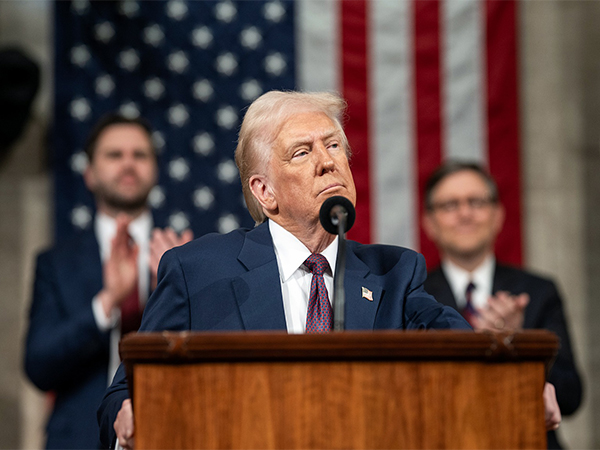
New Delhi: The announcement of new tariffs by US President Donald Trump with the objective to safeguard American industries, are expected to have far-reaching implications not only for the US economy but also for the global GDP and trade. These measures are likely to cause inflationary pressuresand trigger a broader economic slowdown.
India seems to be better prepared to navigate these headwinds compared to many of its global competitors, positioning itself as a more resilient economy in the global eco-system.
Global impact of Trump Tariffs
Trump's tariff strategy primarily targets the trade imbalance by making imports more expensive and incentivizing domestic production. However, this approach comes with significant risks. One of the most immediate consequences is rising inflation within the US, as higher tariffs increase the cost of imported goods. This may reduce consumer purchasing power and put additional pressure on the Federal Reserve to maintain a more cautious approach toward interest rate cuts. As the cost of doing business rises, investment activity may slow down, creating ripple effects across the global economy.
A potential slowdown in global trade is also a major concern. Tariffs disrupt established supply chains, making goods more expensive and less competitive internationally. As trade becomes more fragmented, countries that heavily depend on exports to the USwill suffer revenue losses, reduced production, and job cuts. In this uncertain global environment, the resilience of individual economies will largely determine how well they manage these external shocks.
India’s competitive position in the global trade arena
Amid these global shifts, India appears to be better positioned. While countries such as Vietnam, Myanmar, Sri Lanka China, Bangladesh, and South Africa are expected to face steep tariff rates—ranging from 31% to as high as 46%—India's exposure remains limited, with tariff rates hovering around 26–27%. This comparative advantage enhances India’s competitiveness in the US market
This advantage becomes particularly relevant in labour-intensive sectors such as textiles, garments, electronics, and pharmaceuticals. As companies rethink their sourcing strategies in response to rising tariffs and geopolitical uncertainties, India stands out as a viable alternative. The ongoing shift in global supply chains, accelerated by the pandemic and now by tariff realignments, presents India with a strategic opportunity to enhance its share in global exports.
Since the US- China trade war of 2018, between 2018 and 2023, India’s exports of goods and services grew from USD 529 billion in 2018 to USD 777 billion. During the same period, global exports increased from USD 25,200 billion to USD 31,100 billion. India’s share in global exports rose from 2% in 2018 to 2.5% in 2023, indicating India’ssignificantly improved presence in global exports of goods and services.
Factors boosting India’s economic resilience
India’s ability to withstand global shocks stems from a combination of structural strengths and proactive policy measures. One of the most significant developments in recent months is the softening of inflation. With global commodity prices stabilizing and supply chains gradually recovering from pandemic-related disruptions, inflation in India has shown a downward trend. This not only provides relief to consumers but also create scope for the Central bank to pursue a supportive monetary policy, maintaining liquidity and encouraging growth.
Another pillar of resilience is India’s strong domestic consumption. Unlike many export-reliant economies, India’s growth model is underpinned by internal demand, driven by a large and youthful population. Government welfare schemes, rising middle-class incomes, and increasing urbanization have all contributed to a robust consumer base. Even if export growth slows due to global uncertainties, domestic consumption is likely to remain a steady engine of growth.
Furthermore, India’s improving ease of doing business has provided positive results. Over the past few years, reforms in taxation, digitalisation, and labor regulations have created a more conducive environment for entrepreneurship and foreign investments. These reforms are instrumental in attracting global manufacturers and making India a potential manufacturing hub.
Continued policy support by government
India is better positioned than many of its peers supported by meaningful reforms and decelerated efforts to enhance the ease of doing business and reduced costs of doing business. Improving logistics, streamlining regulatory approvals, and enhancing port infrastructure are supporting Indian products to compete on price and delivery timelines. Also, India is looking beyond traditional Western markets and expand its trade relations with regions like Latin America, Africa, Middle East and Southeast Asia. A more diversified export basket and will help mitigate external risks.
Opportunities in supply chain reconfiguration
One of the most promising outcomes of the current global turmoil is the reconfiguration of supply chains. The world is rapidly moving toward a "China Plus One" strategy, where businesses are looking to reduce their overdependence on China by exploring alternative production bases. India is well-placed to benefit from this transition.
The government's Production Linked Incentive (PLI) schemes have already attracted interest in sectors like electronics, pharmaceuticals, and renewable energy. Apple, for instance, has significantly expanded its manufacturing base in India, signalling growing global confidence. As more firms seek stable, scalable, and cost-effective locations, India can leverage its demographic and infrastructural advantages to become a key node in global production networks.
Short-term challenges and long-term prospects
Though a slowdown in the US and global economy will have spill over effects on India, especially in areas linked to exports and services, the structural reforms undertaken in recent years, along with a favourable demographic profile and strong consumption base, make India one of the few bright spots in the global economy. If India continues to push forward with strategic investments in infrastructure, education and health, it can turn global disruptions into opportunities for sustained growth.
In conclusions, the new Trump tariffs may pose fresh challenges for the global economy. India’s relatively better position combined with strong domestic fundamentals and reform momentum create opportunities for enhanced outreach in global marketplace.
While the short-term may bring some turbulence, the medium to long-term horizon appears promising. As global supply chains realign and trade patterns evolve, India has a historic opportunity to step up as a key player in the world economy.